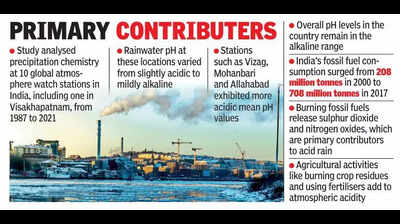- News
- City News
- vijayawada News
- Industrial emissions acidify rainwater in Vizag
Trending
Industrial emissions acidify rainwater in Vizag
Visakhapatnam: Rainwater samples collected from Visakhapatnam between 1987 and 2021, was predominantly acidic primarily due to emissions from numerous industries and sea spray, revealed researchers at the India Meteorological Department (IMD) in Pune and New Delhi, and the Indian Institute of Tropical Meteorology, Pune. They prepared a comprehensive study by examining the precipitation chemistry of rainwater here over the 34-year period. The study analysed this 34-year data across ten global atmosphere watch stations in India, including one in Visakhapatnam.
For the unformed, the pH scale quantifies the acidity or alkalinity of a substance, ranging from zero to 14. A pH below seven signifies an acidic substance, a pH of seven denotes neutrality, while a pH above seven reflects a basic (alkaline) substance.
Atmospheric carbon dioxide dissolves in rainwater to form carbonic acid, giving it a pH of approximately 5.7, which is regarded as CO₂-equilibrated neutral. Rainwater with a pH below 5.7 is more acidic. And when this excess acidity is attributed to pollutants such as sulphate and nitrate, generated by gaseous precursors, it is classified as acid rain. However, according to exports, this minor magnitude of acid rain does not currently pose a substantial and immediate threat to the Vizag region.
Analysis of rainwater samples from Vizag during the dry season indicated that approximately 27.1% of the samples exhibited pH values within the range of 4.5 to 5, whereas during the wet season, about 29.3% of the samples fell within the 5 to 5.5 range.
Despite these fluctuations, the long-term monthly averages consistently indicate that the rainwater remains slightly acidic in Visakhapatnam. Temporal changes in acidic components, specifically non-sea salt sulphate and nitrate, were scrutinised. Non-sea salt sulphate exhibited a marked increase in both dry and wet seasons.
Further analysis of Vizag's rainwater unveiled that nitrate, chloride, and sodium were the most prevalent ions. During the dry season, these ions contributed approximately 18%, 17%, and 16% respectively, while in the wet season they constituted 16%, 19%, and 17% respectively. Elevated sodium and chloride levels pointed to a strong oceanic influence, while heightened nitrate levels were linked to considerable industrial emissions.
IMD director general of meteorology, Dr M Mohapatra, said that IMD's precipitation chemistry laboratory in Pune analysed rainwater samples collected from these stations for the period 1987 to 2021.
"Rapid urbanisation and growth of industries contribute to increased air pollution, thereby altering the chemical composition of rainfall. Studying the composition of rain provides insights into the relative impact of various sources of particulate matter and gases. Assessing the chemical makeup of rainwater enables evaluation of the effects of local pollutants as well as those transported from distant sources," said the director general.
"Changes in precipitation chemistry have become a significant environmental concern in many regions due to the adverse impacts on ecosystems caused by acid deposition. Rainwater pH across these locations ranged from slightly acidic to mildly alkaline," said Dr Mohapatra in the IMD meteorological monograph titled ‘the chemistry of rain: long-term observations and insights from Indian GAW stations.'

About the Author
Umamaheswara RaoEnd of Article
FOLLOW US ON SOCIAL MEDIA







